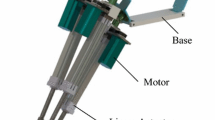Abstract
The static balancing of a spatial 6-degree-of-freedom (6-DoF) decoupling parallel mechanism is discussed in this paper. Two traditional approaches (using counterweights and the springs) are used to statically balance the mechanism. Due to the existence of their shortcomings, a hybrid approach is proposed based on the static balancing of the mechanism. The main feature of this mechanism is that the 3-DoF rotating part can be static balancing itself, which means that its mass has no effect on the gravity balancing of the system, for any configuration of the mechanism, so the rotating part can be considered as a whole and the calculation is simplified. Finally, examples and dynamic analysis corresponding to the three balancing methods are given to illustrate the results.
Similar content being viewed by others
References
J. G. Alvarado, R. R. Castro, C. R. A. Nájera and L. P. González, A novel six-degrees-of-freedom series-parallel manipulator, Journal of Mechanical Science and Technology, 26(6) (2012) 1901–1909.
S. K. Wang, J. Z. Wang and D. W. Shi, CMAC-based compound control of hydraulically driven 6-DOF parallel manipulator, Journal of Mechanical Science and Technology, 25(6) (2011) 1595–1602.
G. Cheng, W. Gu and S. Ge, Kinematic analysis of a 3SPS+1PS parallel hip joint simulator based on Rodrigues parameters, Journal of Mechanical Science and Technology, 26(10) (2012) 3299–3310.
Y. H. Chung, J. H. Choo and J. W. Lee, SenSation: A new 2 DOF parallel mechanism for a haptic device, Transaction on Control, Automation and Systems Engineering, 3(4) (2001) 217–222.
S. K. Agrawal and A. Fattah, Theory and design of an orthotic device for full or partial gravity-balancing of a human leg during motion, IEEE Transactions on Neural Systems and Rehabilitation Engineering, 12(2) (2004) 157–165.
S. K. Banala, S. K. Agrawal, A. Fattah, K. Rudolph and J. P. Scholz, A gravity balancing leg orthosis for robotic rehabilitation, IEEE International Conference on Robotics & Automation, Newark, DE, USA (2004) 2474–2479.
A. Agrawal and S. K. Agrawal, Design of gravity balancing leg orthosis using non-zero free length springs, Mechanism and Machine Theory, 40(6) (2005) 693–709.
S. Lessard, P. Bigras, A. Bonev, S. Briot and V. Arakelian, Optimum static balancing of the parallel robot for medical 3D-ultrasound imaging, 12th IFToMM World Congress, Besancon, France (2007) 18–21.
J. G Wang and C. M. Gosselin, Static balancing of spatial three-degree-of-freedom parallel mechanisms, Mechanism and Mechine Theory, 34(3) (1999) 437–452.
J. G. Wang and C. M. Gosselin, Static balancing of spatial four-degree-of-freedom parallel mechanisms, Mechanism and Mechine Theory, 35(3) (2000) 563–592.
J. G. Wang and C. M. Gosselin, On the design of gravitycompensated six-degree-of-freedom parallel mechanisms, Proceedings of IEEE International Conference on Robotics and Automation, Leuven, Belgium (1998) 2287–2294.
C. M. Gosselin and J. G. Wang, Static balancing of spatial six-degree-of-freedom parallel mechanisms with revolute actuators, Journal of Robotic System, 17(3) (2000) 159–170.
A. Russo, R. Sinatra and F. F. Xi, Static balancing of parallel robots, Mechanism and Mechine Theory, 40(2) (2005) 191–202.
P. Y. Cheng and K. J. Cheng, A gravity balance mechanism used to eliminate the body-weight influence on people with lower-limb disabilities, Technology and Disability, 23(1) (2011) 19–28.
S. K. Agrawal, G. Gardner and S. Pledgie, Design and fabrication of a gravity balanced planar mechanism using auxiliary parallelograms, Journal of Mechanical Design, Transactions of ASME, 123(4) (2001) 525–528.
K. Koser, A cam mechanism for gravity-balancing, Mechanics Research Communications, 36(4) (2009) 523–530.
I. Simionescu and L. Ciupitu, The static balancing of the industrial robot arms Parts II: Continuous balancing, Mechanism and Mechine Theory, 35(9) (2000) 1299–1311.
C. Cho, W. Lee, J. Lee and S. Kang, A 2-dof gravity compensator with bevel gears, Journal of Mechanical Science and Technology, 26(9) (2012) 2913–2919.
Author information
Authors and Affiliations
Corresponding author
Additional information
Recommended by Associate Editor Ki-Hoon Shin
Taoran Liu is currently a Ph.D. candidate in School of Mechanical Engineering, Shanghai Jiao Tong University, China. Her main research interests include parallel kinematic mechanism and applications, design and control of force feedback device.
Feng Gao is currently a full professor in Shanghai Jiao Tong University, China. He received his Ph.D. from Beijing University of Aeronautics and Astronautics, China, in 1991. His research interests include parallel robotics and applications. He patented more than 30 inventions and published around 160 papers.
Rights and permissions
About this article
Cite this article
Liu, T., Gao, F., Zhao, X. et al. Static balancing of a spatial six-degree-of-freedom decoupling parallel mechanism. J Mech Sci Technol 28, 191–199 (2014). https://doi.org/10.1007/s12206-013-1104-9
Received:
Revised:
Accepted:
Published:
Issue Date:
DOI: https://doi.org/10.1007/s12206-013-1104-9




